Introduction to the Atomic Bombing on Hiroshima
Why did America drop Atomic Bombs on Japan?
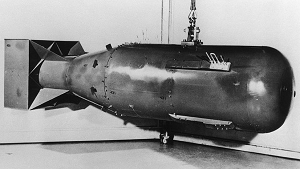 |
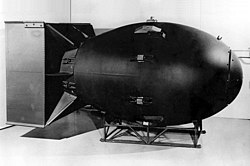 |
| little boy |
fat man |
(1)American traditional strategy
History tells the truth that America is very clever.
|
|
(2) Why did America drop Atomic Bombs to Japan?

Please see below. Because unlike Korean and Chinese Japanese will not demand compensation to the U.S. even if the U.S. says the truth, the U.S. can speak the truth in peace. If the U.S. does so, the foggy feeling of the history will be broken off and you will feel fine. |
| 04 Feb 45 - 11 Feb 45 Yalta Conference
President Franklin Delano Roosevelt U.S. asked Soviet Union to declare war against Japan and fight Japan. U.S. promised to give Soviet Union South Sakhalin, Chishima islands and three votes in the United Nations, etc. Because U.S. did not have A-bomb yet and U.S. needed Soviet Union’s help to put an end to the war. (After the war the Soviet Union owned south Sakhalin and the Chishima Islands as promised, and only the Soviet Union got three (including Ukraine and Belarus) votes in the United Nations.) |
| 12 April 45
President Roosevelt died. Vice President Truman became the President. |
| 17 Jul 45 - 02 Aug 45 Potsdam Conference President Harry S. Truman Potsdam Conference by America, UK and Soviet Union. |
| 21 Jul 45
The president got the report that A-bomb had got built. U.S. changed its mind. U.S. did not need Soviet Union’s help any more as before. |
| 24 Jul 45
The president ordered throwing down A-bomb on Japan without waiting for the second test. |
| 26 Jul 45 Potsdam Proclamation
Potsdam Proclamation to Japan. After the announcement of the Proclamation, Truman reported that to Soviet Union. That means ignoring the Soviet Union. They didn’t say anything about A-bomb and did the last announcement. And no reply of Japan. The Suzuki Cabinet thought that it was the same as “Cairo Declaration” and he said “it has no special value and we ignore that”. |
| 29 Jul 45
Soviet Union asked U.S. and UK to give a formal request document for Soviet Union to fight Japan according to the promise. |
| 31 Jul 45
U.S. did an ambiguous reply to Soviet Union . |
| 06 Aug 45 A-bomb on Hiroshima U.S. tried to put an end to the war without Soviet Union’s help and to rule Japan and other Asian area before Soviet Union invaded Manchuria, Korea, Japan and so on. U.S. showed the Soviet Union that if the Soviet Union disobeyed America, U.S. would drop A-bombs to the Soviet Union too. Also it meant the human experiments. (U.S. tried an uranium atom bomb.) |
| 08 Aug 45 Soviet Union declared war against Japan. Soviet Union thought the war was going to be over because of A-bomb. 2 days after Hiroshima bombing, Soviet Union invaded Manchuria, Korea and Japan in a hurry before war was over and U.S. came there. |
| 09 Aug 45 A-bomb on Nagasaki (U.S. tried a Plutonium atom bomb.) |
| 15 Aug 45
War was over. Japan accepted Potsdam Proclamation. Japan was occupied by America Japan was not devided by U.S. and Soviet Union because of A-bomb. |
These are from the Hiroshima Peace Memorial Museum |
Radiation and Genetic EffectsAfter the A-bombing, it was feared that survivorswould be affected genetically. At this point, a variety of studies have failed to find any harmful effects of radiation in the survivors’ descendants. However, continued long-term observations and reserch will be required. |
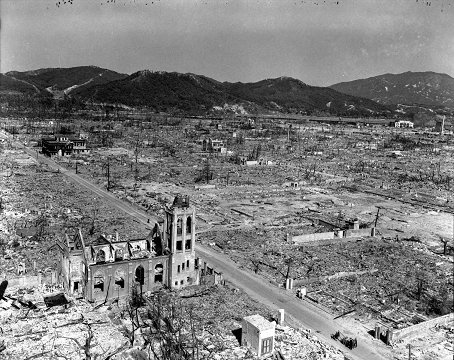 |
The center of the city.Nothing is left standing except ferroconcretebuildings. The following verse is from “Flower of Summer” (Natsu no Hana), a collection of short stories by Tamiki Hara (1905-1951), writer and A-bomb survivor. This is a human being? Look how the atom bomb changed it. Flesh swells fearfully. All men and women lake one shape. The voice that trickles from swollen lips on the festering, charred-black face whispers the thin words, “Please help me.” This, this is a human being. This is the face of a human being. |
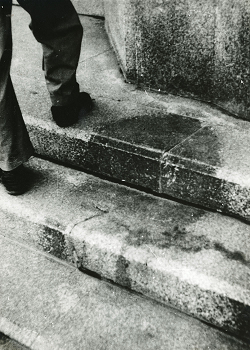 |
Human Shadow Etched in StoneA person sitting on the banksteps waiting for it to open was exposed to the flash from the atomic bomb explosion. Receiving the rays directly from the front, the victim undoubtedly died on the spot from massive burns. The surface of the surrounding stone steps was turned whitish by the intense heat rays. The place where the person was sitting remained dark like a shadow. |
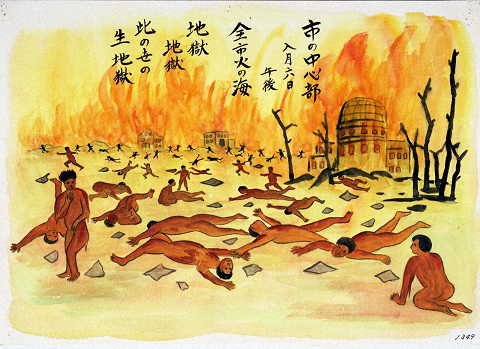 |
Raging flames and corpses scattered everywhereKenichi Nakano(47 at the time of the bombing, 76 when he drew this picture) Explanation in pictureWhole city a sea of fire. Hell. Hell on Earth |
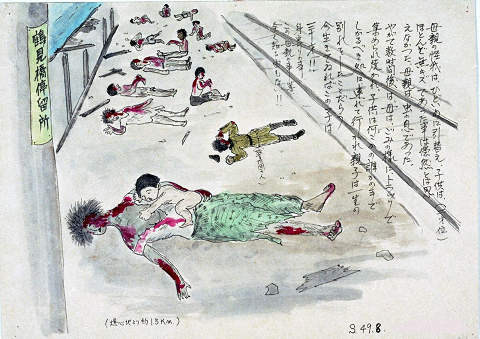 |
A girl clung to her mother who was barely breathing because of injuries over her whole body.
Kazuo Matsumuro(32 at the time of the bombing, 61 when he drew this picture) Explanation in pictureIt was probably not a coincidence that the mother was criticallywounded while her daughter was virtually unscratched. The mother was barely breathing. Several hours later, the mother was piled onto a truck like a piece of trash to be taken for cremation. The child was taken somewhere by someone who would take care of her. Thus, they parted forever. If the daughter lived, she would be 30 now. How would she know anything of her mother or her relatives? |
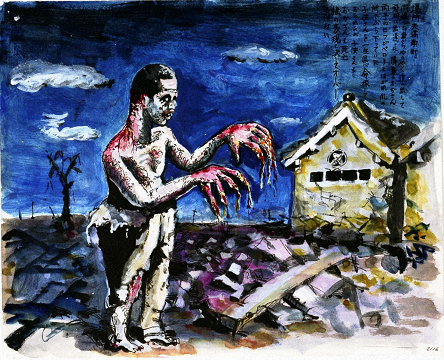 |
The burned skin on both of this man’s arms was peeling and hanging.
Akira Onogi(15 at the time of the bombing, 45 when he drew this picture) Explanation in pictureAfter finally managing to crawl out of our collapsed house, I saw our next-door neighbor for the first time.The skin on both arms had peeled off and hung from his fingernails. He was desperately looking for his child. Both he and the child died. |
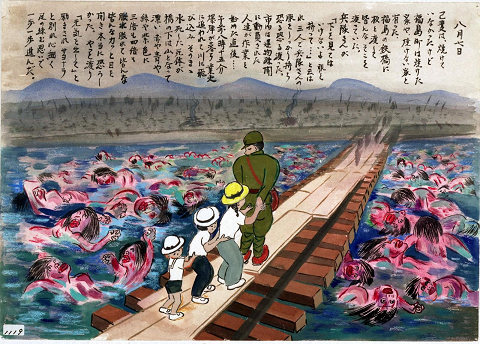 |
As I fearfully crossed the railroad bridge, I saw red, blue, green, and purple corpses swollen three or four times floating under it.
Toshiko Kihara |
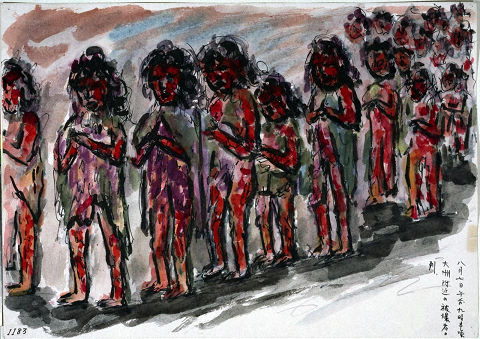 |
A line of victims injured over their whole bodies, fleeing to the suburbs
Masato Yamashita (20 at the time of the bombing, 50 when he drew this picture) Explanation in pictureA line of victims in the Ozu vicinity |
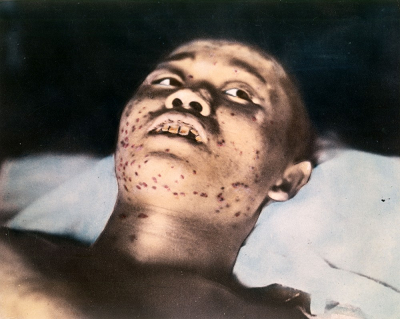 |
A soldier about to die.This serviceman survived the war, but fell a victimto the A-bomb inside a wooden house (about 1km from the hypocenter). Bleeding from the skin, red specks, stomatitis and hair epilation were observed. The soldier died two hours after this photograph was taken. (Photo by Gonichi Kimura) |
Bone marrow displaying acute leukemiaProvided by the Hiroshima Red Cross and Atomic-bombSurvivors Hospital 1,700m from the hypocenter Hiratsuka-cho A 9-year-old girl exposed in a wooden house received no burns or other injuries. She grew up strong and healthy. In June 1959, about fourteen years after the bombing, she suddenly experienced fatigue, dizziness, bleeding from gums, and other symptoms. Her symptoms persisted, and she was hospitalized. In late June the following year, her legs began swelling without subsiding, eventually to the point of bleeding. She died in late July. |
|
 |
LeukemiaLeukemia is cancer of the blood. The white bloodcells multiply wildly without fully maturing. Red blood cells and platelets are reduced, leading to anemia. The white blood cells increase in number but lose normal functioning, which lowers resistance to infection. The incidence of leukemia was greatest 7 to 8 years after the bombing. The younger the survivor was at the time of exposure, the earlier was the onset of leukemia. Malignant tumors (Cancer)Cancers began to increase about 1960. Some cancers for which acorrespondence has been confirmed between distance from the incidence are: myeloma, ovary cancer, urinary tract cancer, tbreast cancer, colon cancer, lung cancer, esophagus cancer, stomach cancer. |